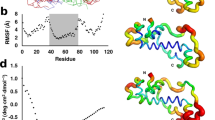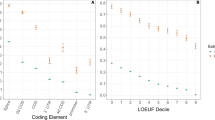Abstract
A large fraction of eukaryotic genomes consists of DNA that is not translated into protein sequence, and little is known about its functional significance. Here I show that several classes of non-coding DNA in Drosophila are evolving considerably slower than synonymous sites, and yet show an excess of between-species divergence relative to polymorphism when compared with synonymous sites. The former is a hallmark of selective constraint, but the latter is a signature of adaptive evolution, resembling general patterns of protein evolution in Drosophila1,2. I estimate that about 40–70% of nucleotides in intergenic regions, untranslated portions of mature mRNAs (UTRs) and most intronic DNA are evolutionarily constrained relative to synonymous sites. However, I also use an extension to the McDonald–Kreitman test3 to show that a substantial fraction of the nucleotide divergence in these regions was driven to fixation by positive selection (about 20% for most intronic and intergenic DNA, and 60% for UTRs). On the basis of these observations, I suggest that a large fraction of the non-translated genome is functionally important and subject to both purifying selection and adaptive evolution. These results imply that, although positive selection is clearly an important facet of protein evolution, adaptive changes to non-coding DNA might have been considerably more common in the evolution of D. melanogaster.
This is a preview of subscription content, access via your institution
Access options
Subscribe to this journal
Receive 51 print issues and online access
$199.00 per year
only $3.90 per issue
Buy this article
- Purchase on Springer Link
- Instant access to full article PDF
Prices may be subject to local taxes which are calculated during checkout


Similar content being viewed by others
References
Fay, J. C., Wyckoff, G. J. & Wu, C. I. Testing the neutral theory of molecular evolution with genomic data from Drosophila. Nature 415, 1024–1026 (2002)
Smith, N. G. & Eyre-Walker, A. Adaptive protein evolution in Drosophila. Nature 415, 1022–1024 (2002)
McDonald, J. & Kreitman, M. Adaptive protein evolution at the Adh locus in Drosophila. Nature 351, 652–654 (1991)
King, M. C. & Wilson, A. C. Evolution at two levels in humans and chimpanzees. Science 188, 107–116 (1975)
Carroll, S. B., Grenier, J. K. & Weatherbee, S. D. From DNA to Diversity: Molecular Genetics and the Evolution of Animal Design (Blackwell Science, Malden, Massachusetts, 2001)
Ludwig, M. et al. Functional evolution of a cis-regulatory module. PLoS Biol. 3, e93 (2005)
Miller, W., Makova, K., Nekrutenko, A. & Hardison, R. Comparative genomics. Annu. Rev. Genomics Hum. Genet. 5, 15–56 (2004)
Cliften, P. et al. Surveying Saccharomyces genomes to identify functional elements by comparative DNA sequence analysis. Genome Res. 11, 1175–1186 (2001)
Gibbs, R. et al. Genome sequence of the Brown Norway rat yields insights into mammalian evolution. Nature 428, 493–521 (2004)
Richards, S. et al. Comparative genome sequencing of Drosophila pseudoobscura: chromosomal, gene, and cis-element evolution. Genome Res. 15, 1–18 (2005)
Shabalina, S. & Kondrashov, A. Pattern of selective constraint in C. elegans and C. briggsae genomes. Genet. Res. 74, 23–30 (1999)
Clark, A. The search for meaning in noncoding DNA. Genome Res. 11, 1319–1320 (2001)
Bustamante, C. et al. The cost of inbreeding in Arabidopsis. Nature 416, 531–534 (2002)
Haddrill, P. R., Halligan, D., Charlesworth, B. & Andolfatto, P. Patterns of intron sequence evolution in Drosophila are dependent upon length and GC content. Genome Biol. 6, R67 (2005)
Halligan, D., Eyre-Walker, A., Andolfatto, P. & Keightley, P. Patterns of evolutionary constraints in intronic and intergenic DNA of Drosophila. Genome Res. 14, 273–279 (2004)
Bachtrog, D. Sex chromosome evolution: molecular aspects of Y chromosome degeneration in Drosophila. Genome Res. 15, 1393–1401 (2005)
Jareborg, N., Birney, E. & Durbin, R. Comparative analysis of noncoding regions of 77 orthologous mouse and human gene pairs. Genome Res. 9, 815–824 (1999)
Bergman, C. & Kreitman, M. Analysis of conserved noncoding DNA in Drosophila reveals similar constraints in intergenic and intronic sequences. Genome Res. 11, 1335–1345 (2001)
Li, W. Molecular Evolution (Sinauer Associates, Sunderland, Massachusetts, 1997)
Tajima, F. Statistical method for testing the neutral mutation hypothesis by DNA polymorphism. Genetics 123, 585–595 (1989)
Kimura, M. The Neutral Theory of Molecular Evolution (Cambridge Univ. Press, Cambridge, 1983)
Charlesworth, B. The effect of background selection against deleterious mutations on weakly selected, linked variants. Genet. Res. 63, 213–227 (1994)
Templeton, A. Contingency tests of neutrality using intra/interspecific gene trees: the rejection of neutrality for the evolution of the mitochondrial cytochrome oxidase II gene in the hominoid primates. Genetics 144, 1263–1270 (1996)
Hudson, R., Kreitman, M. & Aguadé, M. A test of neutral molecular evolution based on nucleotide data. Genetics 116, 153–159 (1987)
Misra, S. et al. Annotation of the Drosophila melanogaster euchromatic genome: a systematic review. Genome Biol. 3, research0083.1-0083.22 (2002)
Glinka, S., Ometto, L., Mousset, S., Stephan, W. & De Lorenzo, D. Demography and natural selection have shaped genetic variation in Drosophila melanogaster: a multi-locus approach. Genetics 165, 1269–1278 (2003)
Haddrill, P. R., Thornton, K. R., Charlesworth, B. & Andolfatto, P. Multilocus patterns on nucleotide variability and the demographic and selection history of Drosophila melanogaster populations. Genome Res. 15, 790–799 (2005)
Yu, J. et al. Minimal introns are not “junk”. Genome Res. 12, 1185–1189 (2002)
Charlesworth, B. Background selection and patterns of genetic diversity in Drosophila melanogaster. Genet. Res. 68, 131–149 (1996)
Acknowledgements
The author thanks D. Bachtrog for extensive comments on the manuscript and help with data quality issues, C. Bustamante and K. Thornton for providing code, and B. Ballard for Zimbabwe fly lines. P. Haddrill and K. Thornton assisted in designing primers for distal intergenic and coding regions, respectively. Thanks to B. Fischman for technical help, A. Betancourt, A. Kondrashov, A. Poon, D. Presgraves, M. Przeworski and S. Wright for critical comments on the manuscript, and L. Chao and J. Huelsenbeck for advice. Thanks also to the Washington University Genome Sequencing Center for providing unpublished D. simulans sequences. This work was funded in part by a research grant from the Biotechnology and Biological Sciences Research Council (UK) to P.A. The author is supported by an Alfred P. Sloan Fellowship in Molecular and Computational Biology.
Author information
Authors and Affiliations
Corresponding author
Ethics declarations
Competing interests
Reprints and permissions information is available at npg.nature.com/reprintsandpermissions. The author declares no competing financial interests.
Supplementary information
Supplementary Notes S1
Regions surveyed in this study. (PDF 157 kb)
Supplementary Notes S2
Assumptions of the McDonald-Kreitman test. (PDF 229 kb)
Supplementary Notes S3
Estimates and confidence limits of α and 2Nes. (PDF 91 kb)
Supplementary Notes S4
Estimating the rate of adaptation. (PDF 84 kb)
Supplementary Notes S5
Adjacent base contexts and rates of divergence. (PDF 45 kb)
Rights and permissions
About this article
Cite this article
Andolfatto, P. Adaptive evolution of non-coding DNA in Drosophila. Nature 437, 1149–1152 (2005). https://doi.org/10.1038/nature04107
Received:
Accepted:
Issue Date:
DOI: https://doi.org/10.1038/nature04107
This article is cited by
-
Application of deep learning in genomics
Science China Life Sciences (2020)
-
Variation of the adaptive substitution rate between species and within genomes
Evolutionary Ecology (2020)
-
Structural variants exhibit widespread allelic heterogeneity and shape variation in complex traits
Nature Communications (2019)
-
Mitochondrial DNA is unsuitable to test for isolation by distance
Scientific Reports (2018)
-
Whole genome SNP-associated signatures of local adaptation in honeybees of the Iberian Peninsula
Scientific Reports (2018)
Comments
By submitting a comment you agree to abide by our Terms and Community Guidelines. If you find something abusive or that does not comply with our terms or guidelines please flag it as inappropriate.



